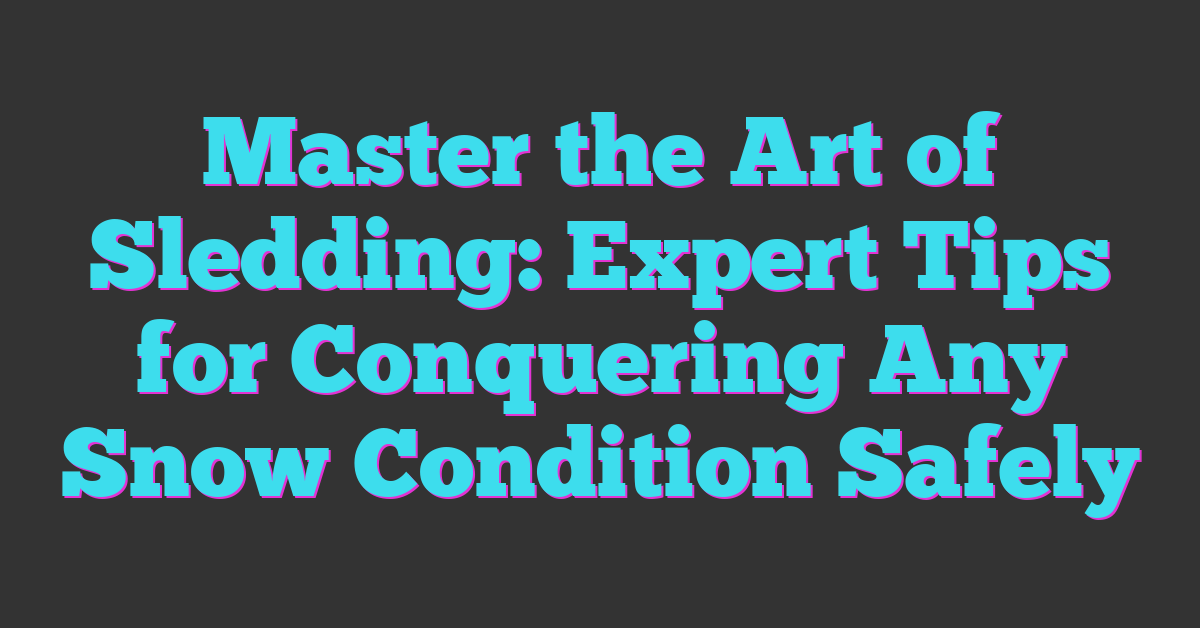Are you ready for some winter fun? When the snow starts falling, it’s the perfect time to grab your sled and head to the nearest hill. But not all snow is created equal when it comes to sledding. In this article, we’ll explore what makes for the best snow for sledding. From the right consistency to the ideal amount of moisture, we’ll cover everything you need to know to have an exhilarating sledding experience. So, get ready to hit the slopes and make the most of the snowy season!

When it comes to sledding, the type of snow you encounter can make all the difference. While fluffy, powdery snow may look appealing, it’s not always the best for sledding. The ideal snow for sledding is packed snow that has a bit of moisture. This type of snow allows for a smooth and fast ride, while still providing enough resistance to keep you in control. So, next time you’re planning a sledding adventure, keep an eye out for the perfect snow conditions.
The Best Types of Snow for Sledding
When it comes to sledding, not all snow is created equal. As an avid winter sports enthusiast, you know that finding the perfect snow conditions can make all the difference in your sledding experience. So, what types of snow should you be on the lookout for? Let’s dive in and explore the qualities that make for the best sledding snow.
Packed Snow
One of the key ingredients for an exhilarating sled ride is packed snow. Unlike powdery snow, which can be fluffy and loose, packed snow has a bit more density and structure. This means it can hold up under the weight of your sled and provide a smooth surface for you to glide on. Packed snow allows for a fast and thrilling ride, ensuring you’ll have a blast with every run.
Moisture Content
Another crucial factor to consider is the moisture content of the snow. While dry, powdery snow is often associated with picture-perfect winter scenes, it may not be ideal for sledding. You want the snow to have just the right amount of moisture to create a good level of resistance. This helps you maintain control over your sled as you zip down the hill. Too dry, and you might find yourself careening out of control. Too wet, and the snow may slow you down too much.
Smooth and Firm
Smoothness and firmness are key characteristics of the best sledding snow. You’re looking for snow that is well-packed and has minimal bumps and uneven surfaces. This allows your sled to glide effortlessly, enhancing your speed and enjoyment. While a small bump or two might add some excitement, an excessively rough surface can make your ride jarring and unpredictable.
Factors That Make Snow Good for Sledding
When it comes to sledding, finding the perfect snow conditions can make all the difference in your experience. As an avid snow sports enthusiast, you know that the quality of the snow can greatly affect the speed and enjoyment of your ride. Let’s explore the factors that make snow good for sledding:
1. Density and Moisture Content
The density and moisture content of the snow are key factors in determining its sledding suitability. An ideal snowpack for sledding is one that is packed and has just the right amount of moisture. When the snow is packed, it provides a solid and smooth surface for your sled to glide on. The moisture in the snow adds a bit of slipperiness, allowing you to gain speed while still maintaining control. Look for snow that feels slightly damp to the touch and holds its shape when packed together.
2. Surface Smoothness
Smoothness is another important factor to consider. A smooth surface ensures a faster and more enjoyable ride. Avoid snow with too many bumps or uneven surfaces, as it can slow you down or even cause you to lose control. Look for areas with a flat or gently sloping terrain, as these tend to have smoother snow surfaces.
3. Firmness and Durability
The firmness of the snow is crucial for a good sledding experience. You want snow that is firm enough to provide resistance for steering and control, but not so hard that it becomes icy. This balance ensures that you can maneuver your sled easily while still feeling a little resistance for stability. Additionally, durable snow that doesn’t easily break or crumble will ensure a smoother ride and reduce the chance of sudden stops or bumps.
Remember, the quality of the snow can vary depending on the weather conditions and time of day. Freshly fallen snow, especially after a light snowfall or overnight freeze, often offers the best sledding conditions. Always be mindful of safety and choose areas that are free from obstacles and hazards.
Ideal Snow Conditions for Sledding
When it comes to sledding, finding the ideal snow conditions can make all the difference in your experience. As an avid snow sports enthusiast, you know that the right type of snow can turn an ordinary sledding adventure into an exhilarating and thrilling ride. So, what exactly are the ideal snow conditions for sledding? Let’s dive in and find out.
Packed Snow: The perfect snow for sledding is packed snow that has just the right amount of moisture. This type of snow offers a smooth and fast ride while still providing enough resistance for control. It allows your sled to glide effortlessly down the hill while keeping you in the driver’s seat.
Smooth and Firm: Nobody likes a bumpy ride, especially when it comes to sledding. Look for snow that is smooth and firm, without too many bumps or uneven surfaces. This ensures a seamless and enjoyable sled run, allowing you to have maximum fun without any unexpected bumps along the way.
Freshly Fallen Snow: For the ultimate sledding experience, aim for freshly fallen snow. After a light snowfall or overnight freeze, the snow is at its prime condition for an exhilarating ride. Fresh snow offers just the right amount of softness, allowing you to carve through it effortlessly and leaving a fresh trail behind.
A Pointer for Safety: While the right type of snow is crucial, safety should always be a top priority. Before sledding, make sure to choose a hill that is safe and free from any obstacles. Always wear protective gear such as a helmet, and sled responsibly.
How to Identify Good Snow for Sledding
As an avid snow sports enthusiast, you know how important it is to find the perfect snow conditions for sledding. The right kind of snow can make all the difference in your sledding experience, allowing for a smooth and thrilling ride down the hill. So, how do you identify good snow for sledding? Here are a few tips to help you out:
- Check for Packed Snow – Packed snow is ideal for sledding because it provides a solid base and offers a faster ride. When you step on the snow, it should feel firm and slightly compressed. This ensures that your sled will glide smoothly down the hill without sinking or getting stuck.
- Look for Moisture – While packed snow is important, it should also have a bit of moisture to increase its slipperiness. Moisture helps reduce friction between the sled and the snow, allowing for better control and speed. If the snow feels too dry and powdery, it may not be the best for sledding.
- Inspect the Surface – A smooth and even surface is crucial for an enjoyable sledding experience. Avoid areas with bumps, rocks, or any obstacles that could make your ride hazardous. The surface should be free from any debris or uneven patches, ensuring a fun and safe descent down the hill.
- Consider Freshly Fallen Snow – After a light snowfall or overnight freeze, the freshly fallen snow can provide some of the best sledding conditions. This snow is usually softer and easier to pack, offering a smoother ride. It also tends to have better moisture content, resulting in faster speeds.
Remember, safety should always be your top priority when sledding. Make sure to choose slopes that are suitable for your skill level and wear appropriate protective gear. With good snow conditions and proper precautions, you’ll have a thrilling and memorable sledding experience every time.
So, get out there and enjoy the winter wonderland on your sled. Find that perfect hill with the right snow conditions, and let the thrill of sledding take you on an unforgettable adventure.
Safety Tips for Sledding in Different Snow Conditions
When it comes to sledding, safety should always be your top priority. As an avid snow sports enthusiast, you understand the importance of taking precautions to ensure a fun and injury-free experience. Whether you’re zipping down a hill on your own or enjoying a thrilling ride alongside friends and family, it’s crucial to be aware of the snow conditions and adjust your sledding technique accordingly.
Here are some safety tips to keep in mind when sledding in different snow conditions:
1. Packed and Firm Snow:
- Look for snow that is packed and firm, as it provides a smooth and more controlled ride.
- Avoid sledding on loose or powdery snow, as it can cause your sled to lose traction and potentially lead to accidents.
2. Icy or Hard Snow:
- Be cautious when sledding on icy or hard snow, as it can increase your speed and make it more difficult to steer.
- Keep your body low to the ground and use your hands and feet to help navigate turns and maintain balance.
- Consider wearing a helmet for added protection, especially if you’re sledding at higher speeds or on steep terrain.
3. Wet and Slushy Snow:
- Wet or slushy snow can be more challenging to sled on, as it can slow you down and make it harder to maintain control.
- Check the condition of the snow before sliding down a hill and adjust your speed accordingly.
- Be mindful of any obstacles or uneven patches that may be hidden beneath the wet snow.
Remember, each snow condition presents its own set of challenges, so it’s important to adapt your sledding technique accordingly. Take the time to assess the snow conditions and choose your sledding spot wisely. By following these safety tips, you can enjoy a thrilling and safe sledding experience every time.
Now let’s move on to the next section – “Best Sledding Hills for Different Snow Conditions.”
Conclusion
Remember, when it comes to sledding, safety is key. In this article, we’ve discussed various snow conditions and provided tips to help you navigate them safely. Whether you’re sledding on packed and firm snow, icy or hard snow, or wet and slushy snow, it’s important to adjust your technique accordingly. Keep an eye out for obstacles and uneven patches, and always wear a helmet for added protection.
Before you head out to your favorite sledding spot, take a moment to assess the snow conditions. Is the snow firm and packed, or is it icy and hard? Perhaps it’s wet and slushy. By choosing the right spot for your sledding adventure, you can ensure a fun and safe experience.
So, grab your sled, bundle up, and enjoy the thrill of sledding. Just remember to stay safe and make the most of the snow conditions. Happy sledding!
















